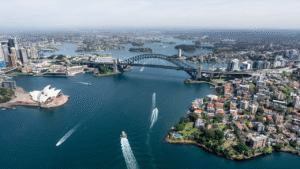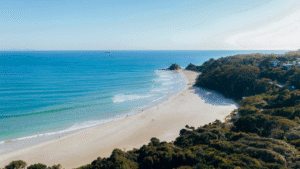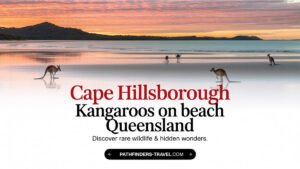Estimated reading time: 19 minutes
Key Takeaways
- The Barossa Valley is one of Australia’s premier wine regions, located approximately 60-75 minutes from Adelaide.
- World-famous wineries like Penfolds, Jacob’s Creek, and Seppeltsfield offer distinctive cellar door experiences that cater to different preferences.
- An Adelaide to Barossa Valley day trip can be enjoyed via self-drive, organized tours, or private chauffeur services.
- The region is particularly known for exceptional Shiraz and Riesling varieties, with most tastings progressing from lighter whites to full-bodied reds.
- Booking wine tastings in advance is highly recommended, especially during weekends and peak tourist seasons.
Table of Contents
- Introduction
- Why Visit Barossa Valley for Wine Tourism
- Planning Your Adelaide to Barossa Valley Day Trip
- Best Wineries in Barossa Valley
- Penfolds vs Jacobs Creek Cellar Door Experience
- Wine Tasting in Barossa Valley: What to Expect
- Tips for a Successful Barossa Valley Wine Tour
- Frequently Asked Questions about the Barossa Valley Wine Region
- Conclusion
Introduction
A Barossa Valley wine tour offers one of Australia’s most celebrated wine experiences, inviting enthusiasts to discover a region steeped in winemaking tradition. Located about an hour’s drive from Adelaide, the Barossa has established itself as a must-visit destination for anyone with an appreciation for exceptional wines. The valley unfolds with lush vineyards stretched across rolling hills, historic cellar doors housed in sandstone buildings, and vineyards producing internationally acclaimed Shiraz and Riesling varieties.
What makes the Barossa truly special is its rich winemaking heritage, carefully preserved through generations of family-owned estates. Many wineries trace their roots back to the 1840s when European settlers first planted vines in this fertile land. Today, these traditions continue alongside modern innovations, creating wines that honor the past while embracing the future.
Whether you’re planning a comprehensive tour of multiple wineries, booking specific tastings at renowned cellar doors, or comparing different experiences at iconic establishments, this guide will help you create a memorable journey through one of Australia’s finest wine regions.
Want to see this for yourself? Click here to watch Barossa Valley in UHD 4K Resolution.
Why Visit the Barossa Valley Wine Region for Tastings and Heritage
The Barossa Valley presents an exceptional landscape of vineyards that roll gently across the horizon, creating a patchwork of emerald green against the auburn Australian soil. This picturesque setting alone draws visitors from around the world, but the true allure lies in the exceptional wine experiences that await. The region’s Mediterranean climate—with warm days and cool nights—creates perfect conditions for producing wines with remarkable depth and character. After exploring Sydney, many travelers make the Barossa Valley their next destination.
The valley is home to some of Australia’s most historic wineries, including the internationally recognized Jacob’s Creek and Penfolds. These establishments aren’t merely places to taste wine—they’re living museums that tell the story of Australian viticulture. At Jacob’s Creek, visitors can walk through vineyards where the first vines were planted in 1847, while Penfolds offers glimpses into the creation of some of Australia’s most collectible wines. [SOURCE]
What truly sets the Barossa apart is its robust winemaking heritage. Many estates are operated by sixth and seventh-generation winemakers who continue family traditions dating back to the 19th century. This deep connection to the land and craft translates into wines with authentic character and sense of place. The region has gained international acclaim for its bold Shiraz, often from vines over a century old, as well as exceptional Rieslings, Grenache, and innovative blends that showcase the winemakers’ creativity. [SOURCE]
The valley’s accessibility makes it perfect for visitors based in Adelaide. Located just 60-75 minutes by car from the city, the Barossa can be experienced as a day trip or a more extended stay. This proximity allows travelers to easily incorporate a wine tour into their South Australian itinerary without complex travel arrangements.

Adelaide to Barossa Valley Day Trip Planning Guide
Organizing an Adelaide to Barossa Valley day trip requires some thoughtful planning to make the most of your wine tour experience. The good news is that several transportation options cater to different preferences and budgets.
Transportation Options
- Self-drive: Renting a car gives you complete flexibility to create your own itinerary and spend as much time as you wish at each winery. The route from Adelaide is straightforward, following the M20 and then the A20 highways. Just remember to plan for a designated driver or use spittoons during tastings to stay safe.
- Coach tours: Several companies offer scheduled group tours departing from Adelaide CBD hotels. These typically include visits to 4-5 wineries with transport in comfortable coaches and the benefit of knowledgeable guides.
- Mini-bus services: For a more intimate experience, small-group tours (8-12 people) provide personalized attention and often access to boutique wineries that larger groups can’t visit.
- Private guides: For the ultimate customized experience, private chauffeur services allow you to design your perfect day with expert guidance and no concerns about driving. [SOURCE]
Timeframes and Scheduling
Most Barossa Valley wine tours follow a similar schedule:
- Departure from Adelaide: Between 8:30-9:30 AM
- Duration: 7-8 hours for a full-day experience
- Return to Adelaide: Around 5:00-6:00 PM
This timeframe allows for visits to 4-5 wineries, a lunch stop, and some scenic drives through the valley. If you’re planning a self-drive trip, consider that most cellar doors open around 10:00 AM and close between 4:00-5:00 PM. Scheduling your first tasting for 10:30 AM gives you a relaxed start while still maximizing your day.
Accommodation Options
While many visitors experience the Barossa as a day trip, staying overnight allows for a more relaxed pace and the opportunity to visit more wineries. Similar to planning a Great Ocean Road trip, considering your accommodation options is essential for multi-day visits.
The main townships of Tanunda, Nuriootpa, and Angaston offer a range of accommodation options:
- Boutique hotels and B&Bs with vineyard views
- Self-contained cottages for privacy and space
- Luxury vineyard retreats for special occasions
- Caravan parks and camping grounds for budget-conscious travelers
Staying in the valley also means you can enjoy dinner at the region’s renowned restaurants without worrying about the drive back to Adelaide.
Best Wineries in Barossa Valley Wine Region
The best wineries in Barossa Valley offer distinctive experiences that showcase the region’s winemaking excellence. From historic estates to innovative boutique producers, here’s a curated selection of must-visit cellar doors.
Iconic Heritage Estates
Seppeltsfield Winery stands as one of the Barossa’s crown jewels, with a history dating back to 1851. What makes this estate truly unique is the unbroken lineage of vintage tawny (port) from every year since 1878. Visitors can taste wine from their birth year directly from the barrel in the remarkable Centennial Cellar. The estate also features beautiful heritage buildings, landscaped gardens, and the JamFactory craft studios where artisans create contemporary works. [SOURCE]
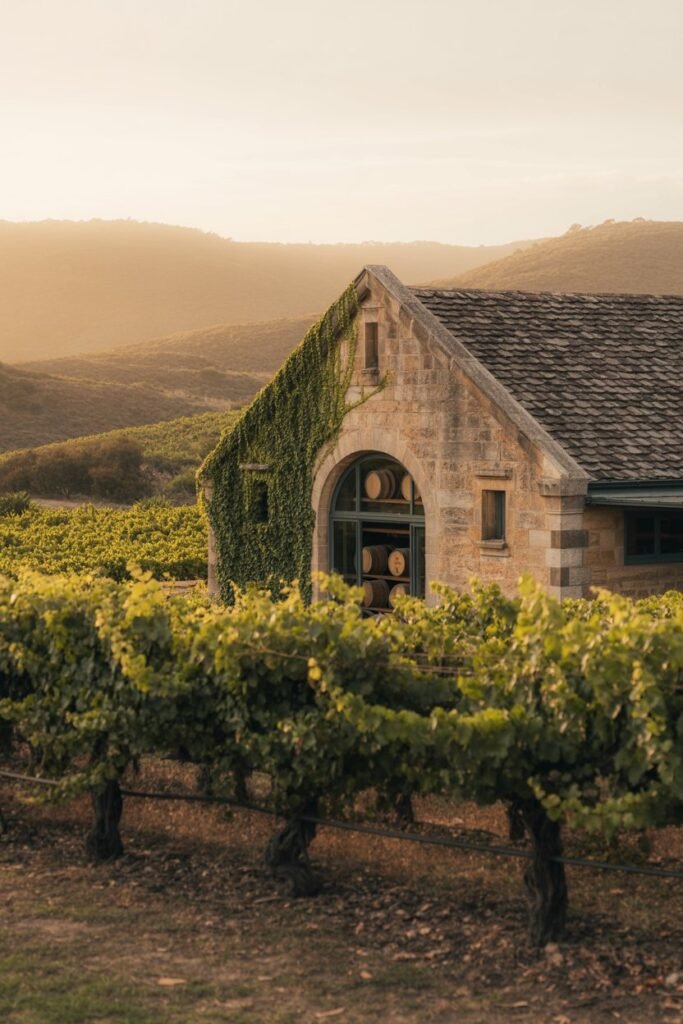
Rockford Wines offers an authentic glimpse into traditional winemaking. This charming stone winery uses equipment and techniques from the 1800s, including basket presses for their flagship Basket Press Shiraz. The rustic cellar door creates an intimate atmosphere where visitors can taste distinctive wines that honor Barossa’s heritage. Their limited-production wines often sell out quickly, making a cellar door visit the best way to secure these sought-after bottles.
Family-Owned Treasures
Langmeil Winery boasts some of the oldest Shiraz vines in the world. Their “Freedom” vineyard, planted in 1843, produces wines from vines that have survived nearly 180 years of Barossa history. The cellar door is housed in a converted blacksmith shop, creating a rustic yet elegant setting for tasting their exceptional wines. Their knowledgeable staff shares stories about the property’s transformation from a small German settlement to an award-winning winery.
Hentley Farm represents the new wave of Barossa excellence. Set in a restored 1840s homestead with stunning views across the valley, this boutique winery focuses on single-vineyard expressions. Their dedication to quality has earned them numerous accolades, including James Halliday’s Winery of the Year. The property also houses one of Australia’s finest restaurants, offering farm-to-table dining that perfectly complements their wines.
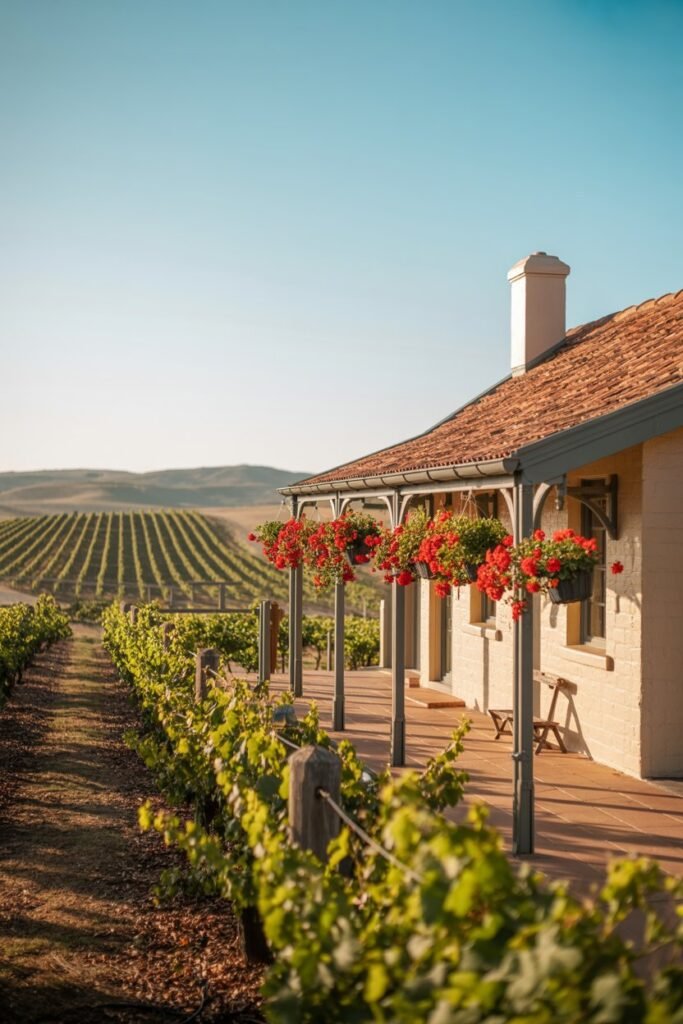
Distinctive Tasting Experiences
Two Hands Wines has revolutionized the tasting experience with their “Vineyard Experiences” program. Visitors can tour specific vineyard sites in rugged 4WD vehicles, tasting wines at the exact locations where the grapes are grown. This ground-to-glass approach provides insight into how the Barossa’s varied terroir influences wine character. Their modern cellar door in Marananga offers structured tastings that showcase regional differences in Shiraz.
Charles Melton Wines specializes in premium Rhône-style reds, including the famous “Nine Popes” GSM blend. The intimate tasting room overlooks their home vineyard, creating a personal connection between visitors and the wines. Charlie Melton was among the first to champion old-vine Grenache in the Barossa, helping preserve these historic plantings when others were removing them. Just like Brisbane’s cultural attractions, these Barossa wineries offer visitors authentic Australian experiences.
Torbreck Vintners has earned international recognition for bold, powerful wines that express the Barossa’s distinctive character. Their tastings often include limited-release wines not available elsewhere, and their historic stone buildings provide a perfect backdrop for experiencing these exceptional wines. The winery’s commitment to working with growers who maintain old, dry-grown vineyards helps preserve the Barossa’s viticultural heritage.
Penfolds vs Jacobs Creek Cellar Door Experience
When comparing the Penfolds vs Jacobs Creek cellar door experiences, visitors encounter two distinctly different approaches to wine tourism, each reflecting the unique character and positioning of these iconic Australian brands.
Penfolds: Heritage and Prestige
The Penfolds cellar door, located at Magill Estate on Adelaide’s outskirts, embodies sophistication and winemaking excellence. The experience centers around their premium portfolio, including the opportunity to taste their flagship Grange—one of Australia’s most celebrated wines. The estate’s historic buildings, dating back to 1844, provide a fitting backdrop for exploring wines that have helped shape Australia’s viticultural reputation.
Penfolds offers several structured tasting experiences:
- Heritage Tastings: Guided sessions featuring their premium range with detailed explanations of each wine’s history and production.
- Make Your Own Blend: An interactive experience where visitors become winemakers, creating their own Shiraz blend from different component wines, then taking home a bottle of their creation.
- Grange Vintage Tastings: For serious enthusiasts, special sessions featuring different vintages of their iconic Grange.
The ambiance at Penfolds is refined and educational, appealing to wine collectors and those seeking depth in their wine knowledge. Staff members possess extensive technical knowledge and can discuss everything from vineyard practices to aging potential. [SOURCE]
Jacob’s Creek: Accessibility and Innovation
Jacob’s Creek Visitor Centre presents a more approachable, inclusive wine experience. Set among vineyards with views of the Barossa Ranges, their modern facility welcomes everyone from first-time wine tasters to enthusiasts. The focus here is on connecting visitors with the landscape, food traditions, and lifestyle associated with wine.
Key experiences at Jacob’s Creek include:
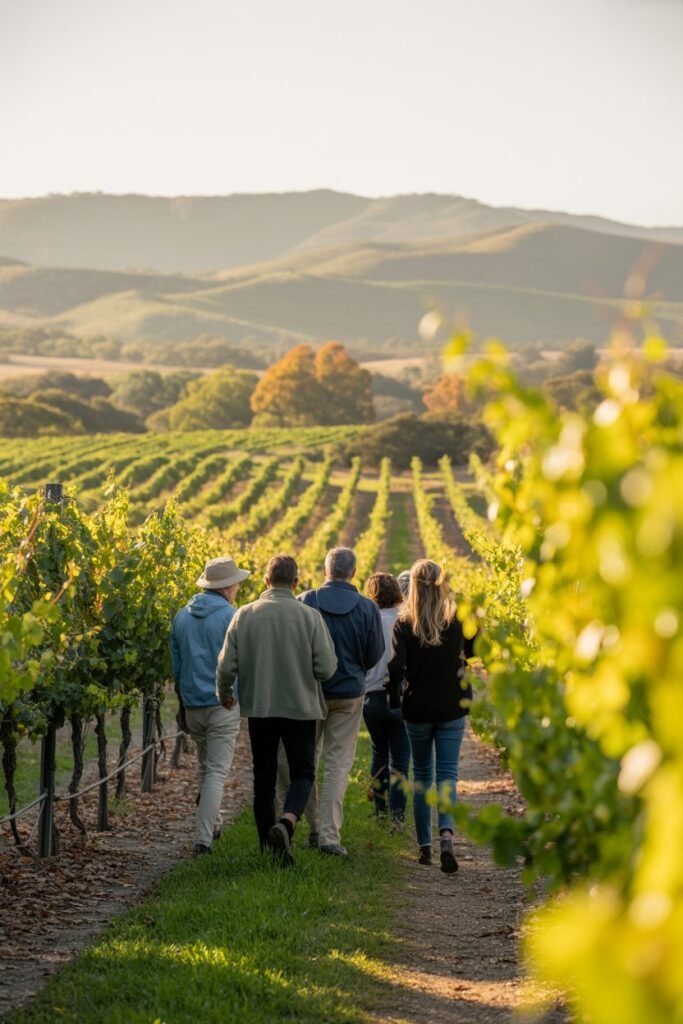
- Vineyard Walks: Guided strolls through the historic vineyards, explaining viticulture practices and the property’s history since 1847.
- Food and Wine Masterclasses: Interactive sessions demonstrating how different foods enhance wine flavors, with hands-on preparation and tasting.
- Heritage Tastings: Flights of reserve and limited-release wines that showcase the brand’s premium offerings.
The Jacob’s Creek visitor experience extends to their restaurant, which features seasonal menus highlighting local produce and designed to complement their wines. The overall atmosphere is relaxed and inviting, with beautiful outdoor spaces for enjoying a glass of wine amid the vines. Similar to Melbourne’s cultural scene, Jacob’s Creek blends tradition with a contemporary approach.
Which Experience Is Right for You?
Choose Penfolds if you:
- Appreciate collectible, age-worthy wines
- Want in-depth technical information
- Are interested in Australian wine history
- Seek exclusive tasting opportunities
Choose Jacob’s Creek if you:
- Prefer a relaxed, scenic setting
- Enjoy food and wine pairings
- Want a more interactive, less formal experience
- Are traveling with companions who have varying levels of wine interest
Many visitors to the Barossa Valley choose to experience both cellar doors to compare these different approaches to Australian winemaking and hospitality.
Wine Tasting in Barossa Valley: Guide to Cellar Door Experiences
Understanding what happens during wine tasting in Barossa Valley sessions helps visitors make the most of their cellar door experiences. Whether you’re a first-time visitor or a seasoned wine enthusiast, knowing the typical process enhances your appreciation of the region’s wines. As with Blue Mountains day trips from Sydney, these premium experiences offer deeper insights into what makes the region special.
The Tasting Process
Most Barossa Valley cellar doors follow a similar format for tastings:
- Welcome and Introduction: Staff greet visitors and explain the winery’s history, philosophy, and available tasting options.
- Structured Progression: Tastings typically move from lighter to fuller-bodied styles—starting with sparkling or white wines, progressing through rosés, and finishing with reds, particularly the region’s famous Shiraz.
- Pour Size: Each sample is usually 15-30ml (about 1 oz)—enough to assess the wine’s characteristics without overwhelming your palate.
- Guidance: Staff provide information about each wine, including vineyard sources, production techniques, and tasting notes. [SOURCE]
Most tastings include 5-8 wines and last approximately 30-45 minutes, though premium or specialized tastings may be longer and more detailed.
Staff Knowledge and Assistance
The cellar door staff play a crucial role in the Barossa tasting experience. These knowledgeable professionals can:
- Help identify wines that match your preferences
- Explain the unique characteristics of Barossa wines
- Share insights about vintages and aging potential
- Suggest food pairings for different wines
- Recommend other wineries that might suit your tastes
Don’t hesitate to ask questions—staff are typically passionate about their wines and eager to share their knowledge.
Tasting Etiquette and Tips
To make the most of your wine tasting experience:
- Pace yourself: Visiting 4-5 wineries in a day allows time to appreciate each without fatigue.
- Use spittoons: If you’re driving or visiting multiple wineries, it’s perfectly acceptable to spit after tasting.
- Take notes: Jotting down impressions helps remember favorites, especially after visiting several wineries.
- Cleanse your palate: Water and plain crackers are usually provided to refresh your taste buds between wines.
- Consider sequence: Visit wineries known for delicate whites earlier in the day when your palate is fresher.
Beyond Basic Tastings
Many Barossa wineries offer enhanced experiences beyond standard tastings:
- Vertical Tastings: Sample multiple vintages of the same wine to understand how they develop over time.
- Food Pairings: Tastings matched with local cheeses, charcuterie, or chocolate to demonstrate how food affects wine flavors.
- Barrel Samples: Some wineries offer the opportunity to taste wines still maturing in oak barrels.
- Private Sessions: Reserve ahead for personalized tastings with winemakers or senior staff. As with Blue Mountains day trips from Sydney, these premium experiences offer deeper insights into what makes the region special.
These specialized tastings typically require advance bookings and may include additional fees, but they provide memorable, in-depth wine experiences.
Tips for a Successful Barossa Valley Wine Tour
Planning ahead ensures your Barossa Valley wine tour will be memorable for all the right reasons. These practical tips will help you maximize your experience in this world-class wine region.
Booking Strategies
Early reservations are essential, particularly for weekend visits and premium experiences. Many sought-after wineries like Rockford, Henschke, and Torbreck have limited capacity and may be fully booked weeks in advance. This is especially true during harvest season (February-April) and festival periods like the Barossa Vintage Festival.
Consider booking a private tasting at least one special winery. While these experiences cost more than standard tastings, they often include access to limited-release wines and personal attention from senior staff or winemakers themselves. [SOURCE]
Creating a Balanced Itinerary
A thoughtful mix of experiences enhances your Barossa journey:
- Combine large and small wineries: Balance visits to iconic estates like Penfolds with smaller, family-run operations such as Kalleske or Hobbs of Barossa Ranges.
- Include different wine styles: While Shiraz is the Barossa’s star, explore other varieties like Grenache, Mataro (Mourvedre), and Eden Valley Riesling.
- Add vineyard walks: Several wineries offer guided tours through their vineyards, providing context about viticulture practices and how the landscape shapes the wines.
- Schedule breaks: Allow time between tastings to rest your palate and reflect on what you’ve experienced.
Aim for quality over quantity—visiting 4-5 wineries with intention is more rewarding than rushing through 8-10 in a day.
Pairing Wine with Food
The Barossa Valley offers exceptional culinary experiences that complement its wines:
- Winery restaurants: Venues like Hentley Farm, St Hugo, and Jacob’s Creek offer excellent dining options paired with their wines.
- Artisan food producers: Include stops at Barossa Valley Cheese Company, Maggie Beer’s Farm Shop, or local bakeries for regional specialties.
- Picnic provisions: Many wineries have picturesque grounds where you can enjoy local produce purchased from the Barossa Farmers Market (Saturday mornings).
A proper lunch break not only provides sustenance but also helps pace your wine consumption throughout the day.
Safety Considerations
Responsible enjoyment of wine is paramount:
- Designate a driver who either abstains or uses spittoons during tastings.
- Book a guided tour with transportation included—this allows everyone in your group to participate fully.
- Stay hydrated by drinking plenty of water between tastings.
- Eat regularly throughout the day to moderate alcohol absorption.
Beyond Wine
Enhance your Barossa experience by exploring beyond the cellar doors:
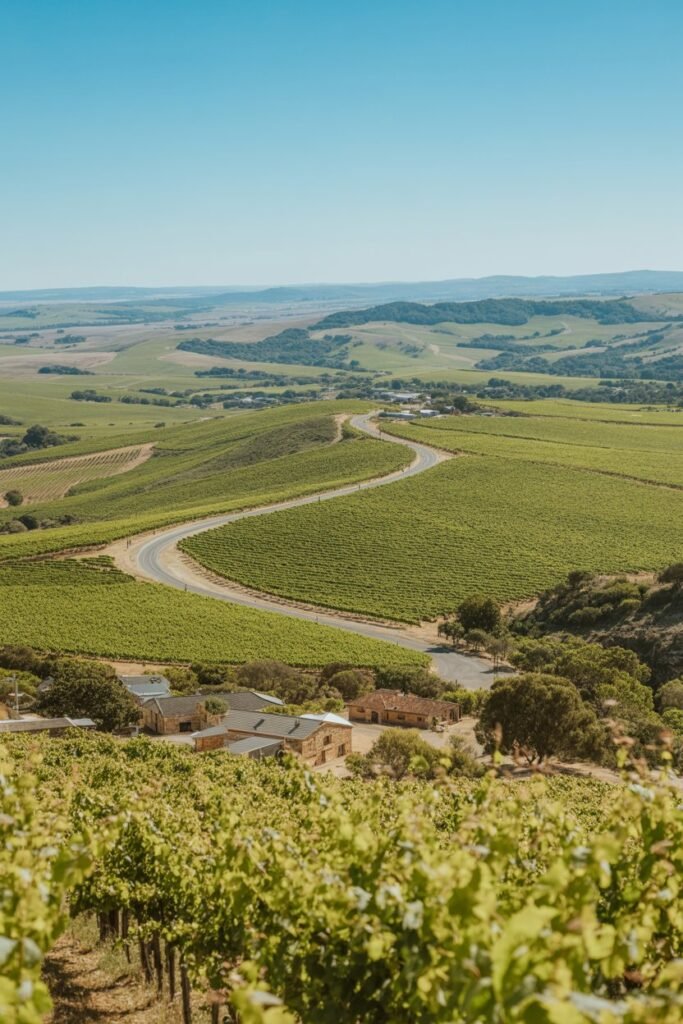
- Scenic lookouts: Mengler’s Hill Lookout offers panoramic views of the valley’s patchwork of vineyards.
- Historical sites: The Barossa’s German heritage is evident in historic towns like Bethany and Tanunda.
- Art galleries: Local artists showcase their work in galleries throughout the region.
- Seppeltsfield Road: This famous avenue, lined with date palms, connects several excellent wineries and food producers. Much like Byron Bay’s attractions, these non-wine experiences add depth to your Barossa visit.
Taking time to appreciate the Barossa’s broader cultural landscape provides context for the wines you’re tasting and creates a more meaningful connection to the region.
Frequently Asked Questions about the Barossa Valley Wine Region
What is the best season to visit the Barossa Valley wine region?
The Barossa Valley wine region is a year-round destination, but the best season is autumn (March to May) when the vineyards turn golden and harvest season brings festivals. Spring (September to November) offers mild weather and greenery, summer can be hot but with pleasant evenings, and winter provides cozy cellar door visits with fewer crowds.
How far is the Barossa Valley wine region from Adelaide city?
The Barossa Valley wine region is located about 60–75 minutes by car from Adelaide city, making it suitable for both day trips and overnight stays. Options include self-drive, coach tours, and private guides. Most tours depart Adelaide between 8:30–9:30 AM and return around 5:00–6:00 PM, allowing time for 4–5 wineries and lunch.
Do I need to book wine tastings in the Barossa Valley in advance?
Yes, advance booking for Barossa Valley wine tastings is recommended, especially on weekends and during harvest or festivals. Popular wineries such as Penfolds, Rockford, and Seppeltsfield often book out quickly. Planning ahead ensures spots at premium tastings and helps balance an itinerary between large and boutique cellar doors.
What can I expect during a wine tasting experience in the Barossa Valley?
A typical wine tasting experience in the Barossa Valley includes 5–8 samples, beginning with lighter wines and finishing with Shiraz. Staff provide tasting notes, vineyard history, and food pairing suggestions. Sessions usually last 30–45 minutes, while premium options may include vertical tastings, barrel samples, or curated food pairings.
Which wineries are a must-visit in the Barossa Valley for first-time visitors?
First-time visitors to the Barossa Valley often include Penfolds and Jacob’s Creek for their contrasting cellar doors, Seppeltsfield for its vintage tawny collection, and Rockford for basket-press Shiraz. Boutique producers such as Langmeil and Hentley Farm offer intimate tastings, while Two Hands and Torbreck showcase modern regional expressions.
Conclusion
A Barossa Valley wine tour provides one of the most rewarding experiences in Australian wine country. The combination of historic estates, boutique producers, and vineyard landscapes creates a setting where every visit tells part of the region’s story. Tastings reveal not only the depth of Barossa Shiraz and Riesling but also the heritage of families who have cultivated these vines for generations.
Visitors can choose from diverse cellar door styles, from the prestige of Penfolds to the relaxed hospitality of Jacob’s Creek, and balance well-known stops with smaller, family-run wineries. The accessibility from Adelaide makes the Barossa an easy addition to a South Australia itinerary, whether for a single day or a longer stay.
Seasonal differences shape the experience: autumn offers harvest activities, spring brings vibrant growth, and winter highlights the valley’s cozy side. Planning ensures access to premium tastings and helps create a balanced route through the valley’s towns and landscapes.
For those expanding their journey, the Barossa pairs well with nearby regions such as Adelaide Hills or the Great Ocean Road. To explore more destinations in depth, see our Sydney travel guide and related Australian itineraries.
Take the first step toward your wine journey today, and prepare to discover why the Barossa Valley holds a special place in the hearts of wine enthusiasts worldwide. To see more of Australia’s incredible destinations in stunning detail, visit Pathfinders Travel on YouTube for 4K travel documentaries featuring the wonders of Australia and beyond.


